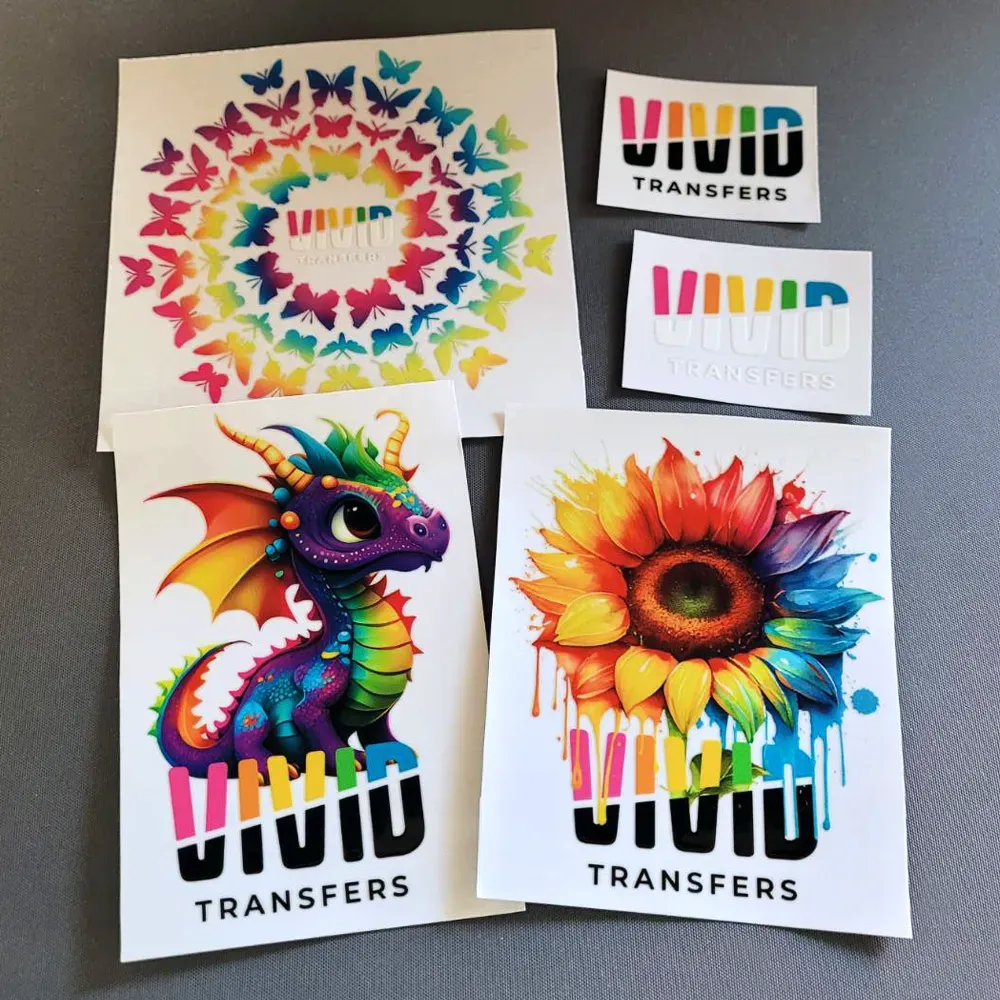In today’s dynamic landscape of printing technology, UV DTF transfers stand out as a revolutionary method for producing eye-catching designs. This innovative approach combines the cutting-edge capabilities of UV printing technology with the practicality of the DTF printing process, allowing creators to achieve vibrant color output on a wide range of materials. Perfect for custom apparel printing and unique promotional items, mastering the art of UV DTF transfers can significantly enhance your design possibilities. In this article, we will guide you through the complete step-by-step process of UV DTF transfers, shedding light on its advantages and recent advancements in this versatile transfer printing technique. Get ready to unlock the full potential of UV DTF transfers and transform your printing projects with stunning results!
As the printing realm continues to evolve, techniques like UV Direct to Film (DTF) transfers are reshaping how designers approach their projects. This hybrid method seamlessly merges UV printing and transfer applications to produce high-quality images that can adhere to various substrates, from textiles to plastics. By incorporating these advanced transfer printing techniques, businesses can effortlessly create customized items that stand out in a crowded marketplace. Not only does this method cater to the growing demand for personalized products, but it also ensures durability and vibrancy in every print. Join us as we explore the intricacies of utilizing UV DTF technology for your creative endeavors.
The Advantages of UV DTF Transfers
UV DTF transfers offer numerous benefits that make them an attractive choice for custom printing. One of the most significant advantages is the ability to achieve vibrant colors and intricate designs with high accuracy. The integration of UV printing technology enhances the resolution and detail, ensuring that every element of the artwork is perfectly captured. This capability is essential for businesses looking to create stunning visuals on a wide range of substrates, including textiles and plastics.
Moreover, the durability of UV DTF transfers cannot be overstated. The curing process involved in the UV printing method hardens the ink instantly, resulting in prints that are both waterproof and resilient. This means that items printed with UV DTF technology can withstand varying environmental conditions, making them suitable for both indoor and outdoor use. As a result, businesses can confidently offer their customers high-quality products that maintain their aesthetic appeal over time.
Understanding the DTF Printing Process
The DTF printing process serves as the backbone of UV DTF transfers, combining artistic expression with technical precision. Initially, the process requires the careful preparation of artwork, where designers must ensure high resolution and correct color representation. This is critical, as any misalignment or poor quality in the graphics can impact the final transfer outcome. Once the artwork is ready, it is printed onto a specific DTF film, employing a UV printer that lays down a white base layer to accentuate color vibrancy, particularly when the design is applied to darker surfaces.
As the DTF film is printed, the quality of both the film and printer plays a pivotal role in the success of the transfer process. The choice of high-quality materials not only enhances the colors but also ensures that the prints are long-lasting. This meticulous attention to detail in the DTF printing process leads to superior, professional-looking transfers suitable for custom apparel, promotional products, and more.
The Versatile Applications of UV DTF Transfers
UV DTF transfers are remarkably versatile, allowing for printing on a myriad of substrates beyond just fabrics. This adaptability makes them an ideal choice for various industries including fashion, interior decor, and merchandise design. Whether creating custom apparel, promotional items, or novelty gifts, the ability to print on materials like plastic, wood, glass, and ceramics expands the scope of artistic possibilities. Businesses can showcase unique designs easily, catering to a wider audience.
This versatility also means that UV DTF transfers can be utilized for small-scale custom projects as well as larger production runs. Such flexibility in applications not only helps businesses meet specific customer demands but also allows for experimentation with different surfaces and substrates. As technology continues to advance, the range of materials that UV DTF can be printed on will likely expand even further, making it a valuable asset in the printing industry.
The Importance of Heat Press Application
One of the crucial steps in the UV DTF transfer process is the heat press application. This technique ensures a solid bond between the printed design and the substrate material. The heat press works by applying a specific combination of heat and pressure for an adequate duration, which is essential to achieve a successful transfer. Without this method, the adherence of the design could be compromised, leading to peeling or fading over time.
Furthermore, various factors such as the temperature, pressure, and timing must be finely tuned to suit different substrates. This adaptability is what makes the heat press method so vital—it allows for customization based on the material being used. Proper applications not only facilitate optimal results but also enhance the durability of the design, ensuring that it can withstand everyday use and maintain its visual integrity over time.
Recent Innovations in UV Printing Technology
Recent developments in UV printing technology have significantly improved the capabilities of UV DTF transfers. Innovations in ink formulations have led to more durable and environmentally friendly options, catering to the growing demand for sustainable printing solutions. These advancements enable printers to achieve even greater vibrancy while minimizing their ecological footprint, making UV DTF an appealing choice for eco-conscious consumers and businesses alike.
Additionally, the technological advancements have also given rise to more efficient printing equipment, which not only boosts productivity but also enhances the quality of the transfers. With these improvements, businesses can expect quicker turnaround times without compromising the integrity of their designs. As the market for custom printing continues to expand, these innovations set the stage for UV DTF transfers to remain competitive and relevant in the changing landscape of printing technology.
Maximizing the Benefits of UV DTF Transfers in Your Business
To truly capitalize on the advantages of UV DTF transfers, businesses must integrate this technology strategically into their operations. This entails not only investing in high-quality UV printers and materials but also ensuring that all staff are adequately trained in the relevant techniques and processes. Proper training can help reduce errors in the artwork preparation and application phases, thus ensuring that finished products meet the high standards expected by consumers.
Furthermore, taking the time to understand customer preferences and market trends can allow businesses to tailor their offerings effectively. By leveraging the capabilities of UV DTF transfers, businesses can create unique products that stand out from the competition. This customization aligns with consumer demands for personalized items, ultimately leading to increased customer satisfaction and loyalty.
Frequently Asked Questions
What are UV DTF transfers and how do they work?
UV DTF transfers, or UV Direct to Film transfers, are a hybrid printing technique that combines UV printing technology and DTF printing processes to produce vibrant designs on various surfaces. By printing high-quality images onto a specially coated film and curing them with UV light, these transfers deliver durable, waterproof designs suitable for custom apparel and other substrates.
What makes UV DTF transfers a preferred choice in custom apparel printing?
UV DTF transfers are preferred in custom apparel printing due to their ability to produce vivid colors and intricate details on both light and dark materials. The process offers versatility, allowing for prints on textiles, plastics, wood, and more, making it ideal for diverse design requirements.
What materials can be used with UV DTF transfer printing?
UV DTF transfer printing is versatile and can be applied to a wide range of substrates, including textiles, plastic items, wood, and even glass. This capability allows businesses to create custom apparel, promotional products, and more using this innovative transfer printing technique.
How is the heat press application performed for UV DTF transfers?
The heat press application for UV DTF transfers involves positioning the adhesive-coated film on the desired substrate and applying heat and pressure using a heat press. This step is crucial for ensuring that the transfer properly bonds to the material, resulting in a durable and high-quality design.
What are the main advantages of using UV DTF transfers over traditional printing methods?
The primary advantages of UV DTF transfers over traditional printing methods include vibrant color capabilities, quick curing times, and durability of the designs. UV DTF also allows for printing on a variety of materials, making it a versatile choice for custom projects.
Are there any recent innovations in UV DTF printing technology?
Yes, recent innovations in UV DTF printing technology include advancements in ink formulations that improve durability and eco-friendliness. Additionally, increased adoption by small businesses has made this printing method more accessible, enabling a broader range of custom printing applications.
| Step | Description |
|---|---|
| 1. Preparation of Artwork | Create high-resolution designs using graphic design software with attention to color accuracy. |
| 2. Printing on DTF Film | Print the finalized artwork onto a specially coated DTF film using a UV printer, including a white base layer for darker substrates. |
| 3. Curing the Print | Cure the printed film with UV light to harden the ink, ensuring durability and waterproof qualities. |
| 4. Applying Adhesive | Apply a heat-activated adhesive to the cured print, either immediately or by using adhesive powder. |
| 5. Heat Pressing | Use a heat press to bond the adhesive-coated film to the substrate, applying adequate heat and pressure. |
| 6. Peeling the Film | Carefully peel away the film to reveal the beautifully adhered design on the substrate. |
| 7. Final Curing (If Necessary) | Optionally, perform a final curing under UV light for enhanced durability if the product requires it. |
Summary
UV DTF transfers revolutionize the printing landscape, providing an effective method for producing vibrant, high-quality designs across a myriad of materials. This process combines the precision of UV printing with the flexibility of transfer techniques, ensuring that each artwork is not only visually appealing but also durable and waterproof. As the printing industry embraces these advanced technologies, the ability to effortlessly create customized designs will significantly elevate product offerings for businesses, allowing them to stand out in a competitive marketplace. By mastering the step-by-step process of UV DTF transfers—from preparing artwork to final curing—creators can unleash the full potential of their designs, meeting the increasing consumer demand for unique and high-quality custom prints.


